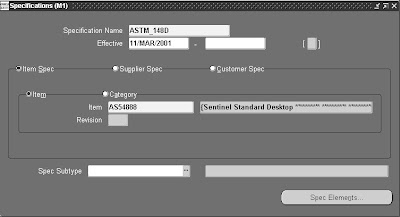Shortnames for Oracle Applications products1)ABM - Activity Based Management
2)AD - Applications DBA
3)AHL - Oracle Advanced Service Online
4)AK - Oracle Common Modules-AK
5)ALR - Oracle Alert
6)AMF - Oracle Fulfillment Services
7)AMS - Oracle Marketing
8)AP - Oracle Payables
9)AR - Oracle Receivables
10)AS - Oracle Sales
11)ASG - Oracle CRM Gateway for Mobile Services
12)ASL - Oracle Mobile Field Sales Laptop
13)ASO - Oracle Order Capture
14)AST - TeleSales
15)AX - Global Accounting Engine
16)AZ - Application Implementation
17)BEN - Oracle Advanced Benefits
18)BIC - Customer Intelligence
19)BIL - Sales Intelligence
20)BIM - Marketing Intelligence
21)BIS - Oracle Applications BIS
22)BIX - Call Center Intelligence
23)BNE - Oracle Web ADI
24)BOM - Oracle Bills of Material
25)BSC - Balanced Scorecard
26)CCT - Oracle Call Center and Telephony
27)CE - Oracle Cash Management
28)CHV - Oracle Supplier Scheduling
29)CLN - Supply Chain Trading Connector for RosettaNet
30)CN - Oracle Sales Compensation
31)CS - Oracle Service
32)CSC - Customer Care
33)CSD - Depot Repair
34)CSE - Oracle Enterprise Install Base
35)CSF - Field Service
36)CSI - Install Base
37)CSM - Oracle Field Service Palm
38)CSP - Oracle Spares Management
39)CSR - Oracle Scheduler
40)CSS - Support
41)CUG-Oracle Citizen Interaction Center
42)CUN - Oracle Network Logistics NATS
43)CZ - Oracle Configurator
44)EAM - Oracle Enterprise Asset Management
45)EC - Oracle e-Commerce Gateway
46)ECX - Oracle XML Gateway
47)EDR - Oracle E Records
48)ENG - Oracle Engineering
49)FII - Financials Intelligence
50)FLM - Oracle Flow Manufacturing
51)FND - Application Object Library
52)FTE - Oracle Transportation Hub
53)FV - Oracle Federal Financials
54)GHR - Oracle Federal HR
55)GL - Oracle General Ledger
56)GMA - Oracle Process Manufacturing Systems
57)GMD - Oracle Process Manufacturing Product Development
58)GME - Oracle Process Manufacturing Process Execution
59)GMF - Oracle Process Manufacturing Financials
60)GMI - Oracle Process Manufacturing Inventory
61)GML - Oracle Process Manufacturing Logistics
62)GMP - Oracle Process Manufacturing Process Planning
63)GMS - Oracle Grants Accounting
64)GR - Oracle Process Regulatory Mgmt
65)HRI - Human Resources Intelligence
66)HXC - Oracle Time and Labor
67)HXT - Oracle Time and Labor Rules
68)IBA - iMarketing
69)IBC - Oracle iContent
70)IBE - iStore
71)IBU - iSupport
72)IBY - iPayment
73)ICX - Oracle Self-Service Web Applications
74)IEB - Oracle Interaction Blending
75)IEC - Oracle Campaign Plus
76)IEM - Oracle eMail Center
77)IEO - Call Center Technology
78)IES - Scripting
79)IEU - Oracle Universal Work Queue
80)IEX - Oracle Collections
81)IGC - Commitment Administration
82)IGF - Student Systems Fin Aid
83)IGI - Oracle International Public Sector Financials
84)IGS - Oracle Student Sytems
85)IGW - Oracle Grants Proposal
86)INV - Oracle Inventory
87)IPD - Oracle Product Development Exchange
88)ISC - Supply Chain Intelligence
89)JTF - CRM Foundation
90)JTM - Oracle CRM Mobile Foundation
91)JTS - Oracle CRM Self Service Administration
92)MRP - Oracle Master Scheduling/MRP
93)MSC - Oracle Advanced Supply Chain Planning
94)MSD - Oracle Demand Planning
95)OFA - Oracle Assets
96)OKC - Oracle Contracts Core
97)OKI - Oracle Contracts Intelligence
98)OKL - Oracle Lease Management
99)OKR - Oracle Contracts for Rights
100)OKS - Oracle Contracts Service Module
101)ONT - Oracle Order Management
102)OPI - Operations Intelligence
103)OTA - Oracle Training Administration
104)OZF - Funds & Budgets
105)PA - Oracle Projects
106)PAY - Oracle Payroll
107)PER - Oracle Human Resources
108)PJM - Oracle Project Manufacturing
109)PN - Oracle Property Manager
110)PO - Oracle Purchasing
111)POA - Purchasing Intelligence
112)POM - Oracle Exchange
113)PON - Oracle Sourcing
114)POS - Internet Supplier Portal
115)PQH - Oracle Public Sector HR
116)PSA - Public Sector Applications
117)PSB - Oracle Public Sector Budgeting
118)PSP - Oracle Labor Distribution
119)PV - Partner Relationship Management
120)QA - Oracle Quality
121)QP - Oracle Pricing
122)QRM - Oracle Risk Management
123)RG - Application Report Generator
124)RLM - Oracle Release Management
125)VEA - Oracle Automotive
126)WIP - Oracle Work in Process
127)WMS - Oracle Warehouse Management System
128)WSH - Oracle Shipping
129)WSM - Shop Floor Management
130)XDP - Oracle Provisioning
131)XNC - Oracle Sales for Communications
132)XNI - Oracle Install Base Intelligence
133)XNP - Oracle Number Portability
134)XNS - Oracle Service for Communications
135)XTR - Oracle Treasury



